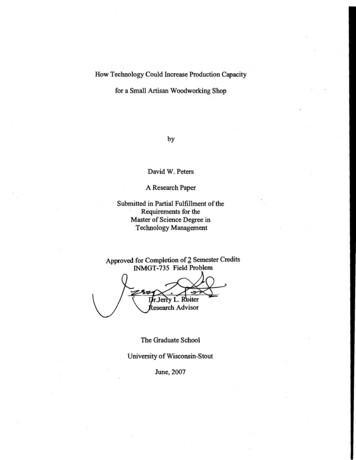
Transcription
How Technology Could Increase Production Capacityfor a Small Artisan Woodworking ShopbyDavid W. PetersA Research PaperSubmitted in Partial Fulfillment of theRequirements for theMaster of Science Degree inTechnology ManagementApproved for Completion of 2. Semester CreditsINMGT-735 Field ProblemThe Graduate SchoolUniversity of Wisconsin-StoutJune, 2007
11The Graduate SchoolUniversity of Wisconsin-StoutMenomonie, WIAuthor:Peters, David W.Title:How Technology Could Increase Production Capacity for aSmall Artisan Woodworking ShopGraduate Degree/ Major: MS Technology ManagementResearch Adviser:Jerry L. Roiter, Ph.D.Number of Pages:41Style Manual Used: American Psychological Association, 5th editionABSTRACTComputer Aided Design (CAD), Computer Aided Manufacturing (CAM), and ComputerNumeric Control (CNC) routers have revolutionized the commercial woodworkingindustry. Over the past decade, these technologies have become viable for small customwoodshops which specialize in low-volume, high quality custom work. Understandinghow these technologies are reshaping the woodworking and woodcarving industries andhow they can be utilized to maximize productivity and profit is a necessity for those whowish to remain competitive.This study will explore how these technologies are being utilized currentlythroughout the woodworking and woodcarving industries and will demonstrate how theseTechnologies could add value by optimizing the production process of a smallwoodworking shop.
IIIACKNOWLEDGEMENTSI would like to thank Dr. Jerry Roiter for his insight and guidance throughout thisprocess.
IVTABLE OF CONTENTS. PageABSTRACTiiList of Tablesvi. 0 fFIgures'LIst.vnChapter I: IntroductionIStatement ofthe ProblemIPurpose ofthe StudyICompany Background1Definition ofTerms3Methodology3Chapter II: Literature ReviewCAD44Design Origination5Communication7CAM/eNCArchitectural WoodworkingWood CarvingChapter III: Methodology1011.1215Subject Elements15Data Collection15Chapter IV: Results.Current Production Process ofABC.1616
v5 Elements ofProduction Process,16Product Process Flow-Chart17Detailed Description ofthe 5 Elements ofProduction Process17Bidding & Design18Fabrication20Carving21Assembly23Finish & Installation24Opportunities for Implementing Technology"2525How Technology Could Improve ABCs Production ProcessBidding & Design25Fabrication27Carving27Assembly"Proposed Production-Process Utilizing TechnologyInitial Time SavingsPotential Time SavingsChapter V: DiscussionConclusionsReferences"2929".2931313133
VIList of TablesTable I: Production Process Percentage Data Based on Historical Data16Table 2: Bidding & Design Historical Data18Table 3: Fabrication Process Historical Data20Table 4: Carving Process Historical Data21Table 5: Assembly Process Historical Data23Table 6: Finish and Installation Process Historical Data24Table 7: Proposes Production Process Based on Historical Data.30
VllList of FiguresFigure 1: Flow-Chart of ABCs Current Production-Process17Figure 2: Critical-Path Flow-Chart of ABCs Current Production-Process17Figure 3: Proposed Production-Process Utilizing Technology30Figure 4: Proposed Production-Process Utilizing Technology Critical-Path31
1Chapter I: IntroductionStatement ofProblemThe use of technology to gain a competitive advantage in business was oncelimited to large companies producing very large quantities of homogeneous products.However, with the increase in the affordability and power of the personal computer overthe last decade, software designers are now creating products with the small quantity,highly customizable producers in mind. The result has been products that are scalable,easy to use, highly customizable, and, most importantly, affordable. The availability andaccuracy of this technology has reshaped virtually every industry and product weencounter, including woodworking. As the nature of their industry is redefined, smallone or two person woodworking shops are being forced to adapt to stay competitive.Purpose ofthe StudyThe purpose of this study is to explore the way in which technology is changingthe woodworking industry and to demonstrate how utilizing Computer Aided Design(CAD), Computer Aided Design (CAM), and Computer Numerical Controlled (CNC)routers would add value for a small woodworking shop which specializes in customcarved wood furniture. For the purposes of anonymity, the name of the woodworkingshop will not be disclosed and will heretofore be identified as ABC for the purposes ofthis paper.Company BackgroundABC is an owner operated woodworking shop which specializes in creatingtraditional Orthodox carved furniture pieces. The shop, consisting of the owner and 1assistant, has been in business for 9 years and serves a nationwide clientele. The
2products ABC produces vary in size and complexity and can take anywhere from 200hours to 3500 hours to complete. All shop operations are currently done manually; theseinclude bidding and design, fabrication, carving, assembly, and finishing of the product.The shop is currently only utilizing technology in the form of a website for advertisingand bookkeeping software.ABC is currently operating at capacity given the current size of its shop, staff, andproduction methods. Faced with the need to add capacity without expanding in size,ABC is seeking to expand its capacity by refining its production process through thetargeted use of technology.
3Definition ofTermsComputer Aided Design, abbr. CAD. "The use of computer programs andsystems to design detailed two- or three-dimensional models of physical objects, such asmechanical parts, buildings, and molecules. (The American Heritage Dictionary of theEnglish Language, Fourth Edition. r Aided Manufacturing, abbr. CAM "The processes of using specializedcomputers to control, monitor, and adjust tools and machinery in manufacturing." (TheAmerican Heritage Dictionary of the English Language, Fourth )Computer Numeric Control, abbr. CNC. Manufacturing machines that areoperated using "G-Code" created by a CAM software program.Critical-Path. "The necessary path or sequence from start to finish, determiningthe time needed for completion; the longest most time-consuming path in a network."(The American Heritage Dictionary of the English Language, Fourth tical path)MethodologyThis study will be conducted in the following manner. It will identify newtechnology and how it is being utilized in the field of woodworking and woodcarving.The study will further describe ABCs current production process, and identifyopportunities where incorporating CAD/CAM or CNC could add capacity by refining theproduction process.
4Chapter II: Literature ReviewIn an era of global competition and specialization, the woodworking industry hasbeen forced to evolve technologically to remain competitive. "As they go head-to-headwith the world's low cost labor regions, American manufacturers are looking for the mosteffective ways to bring new efficiency and flexibility to the shop floor" (Summers, 2003,p. 89). This search for efficiency and flexibility led the industry to begin adaptingtechnologies from other industries such as Computer Aided Design (CAD) and ComputerAided Manufacturing (CAM) software and Computer Numeric Control (CNC) routers."CAD/CAM software originated in metalworking and precision manufacturing, but overthe past five or 10 years, it has made a dent in the woodworking industry. Today,woodworkers can choose from an extensive range of products developed especially forthem (Bury, 2006, p. 179). These new woodworking specific software programs havebeen reshaping the competitive nature of the industry and have become a vital part of acompany's success. To put it succinctly: "Computers are becoming more of a necessitythan a luxury for today's woodworkers, especially when it comes to designing andmachining a project in a timely manner and at a competitive price." (New Software,1997,p.53)CADThe ability to bring new products from idea to production quickly and accuratelyis an essential part of the woodworking industry. J. Harold Kirby described theimportance of product development on the industry this way:
5Let's not forget what we do. We are manufacturers offumiture and woodproducts and our competitive position in the marketplace is dependent onour ability to get product to the market faster, with a better value, at theleast cost to our company. But the old ways and old thinking will leadyou to the inevitable position of non-competitiveness (1997, p. 45).In the search to increase their competitiveness, many in the industry have found"CAD provides the most productive environment in which to manage and modifyengineering documents" (Wilson, 1993, p. 100). CAD offers the user the abilityto better manage its new product development through increased designorigination and communication capabilities.Design OriginationCAD offers several ways to originate the initial two-dimensional (2D) or three dimensional (3D) "electronic equivalent of a blueprint, in formats such as IGES, DXF, orDWG" (Bury, 2006, p179). This can be done by (a) creating a new file, (b) modify anexisting file, and (c) scanning existing designs and prototypes.Creating a new fileAs manufacturers provide CAD programs specifically for the woodworker, theefficiency of creating new files has increased. "Most of the new generation ofCAD/CAM programs start with libraries of standard parts, or templates, and allow usersto modify them to fit their customers needs or to create whole new parts and products"(Bury, 2006, p. 181). The use of these templates can translate into substantial saving indesign time. Walt Moore, a cabinet maker who began using KCDw, a cabinet specific
6CAD program, stated, " .once he learned how to use it, the software turned eight hoursof work into 1-1/2 hours"(Sampson, 2005, p. 35).Modifying an existingfileAnother method of creating the CAD file is to modify an existing file, since allprevious "designs can be saved and used again."(O Rourke, 1993, p. 58). This allowsdesigners to edit only the necessary elements, rather than completely recreate the design"which speeds product development and lowers costs" (0 Rourke, 1993).The ability to modify existing files applies not only to files created in a CADprogram. "Developers for illustration and publishing software quickly adopted DXF forits ability to import and export" Cad files, "making it a de facto standard." (0 Rourke,1993) This flexibility allows consumers to bring their ideas, generated "in the bestprogram for a task, and export the work back to the CAD file." (0 Rourke, 1993) Thisstep again eliminates the need to totally recreate the CAD drawing when such a fileexists. Not only is this faster than redrawing the object, it reduces the opportunity forinput error that is inherent in any redesign.Scanning Existing Designs & PrototypesIn addition to drawing and modifying files, scanning pictures, documents, andprototypes are other options CAD offers for design origination. For those who havemanually drafted blueprints, CAD conversion and Raster Drafting are two "scanner based technologies" that allow the designs to be converted for use in CAD. This is agreat benefit to companies who have a large design portfolio, as they are able to build adigital library of past designs for future use and modification.
7Scanning is not just limited to drawings and designs; companies can use 3-Ddigital scanning to create CAD files from existing prototypes. The scanner creates dataoutput files in the form of surface-mesh and cloud-points. These files can be convertedinto DWG and DXF format for CAD use. The scans offer a level of complexity thatwould be almost impossible to generate by drawing. "I am not sure how long it wouldhave taken using CAD software, or whether it could have been done at all because of thesculpture's complex and detailed surfaces," said Jordan Peppin when asked about adigital scan his company did of a fish sculpture. However, using the scanner, "Peppinestimates it took about four hours to create the distal fish model." (Moltenbrey, 2001, p.50)CommunicationOnce the initial CAD file is originated, it serves as the backbone for the rest of theproject. From this file, the information can be communicated to all necessary parties toproceed with the editing and revision of the design. CAD provides an unparalleledability to communicate through the use of 3-D modeling and the ability to transmit thefile via e-mail.3-D ModelingThe ability to create and view a three dimensional (3D) model using CAD is anincredibly powerful tool for saving time and improving accuracy in the design process.This capability is helpful with communicating with both the design principals, as well asthose tasked with production.
8Design Principals.One way creating a 3-D model of the project can reduce timeis that it allows all involved in the process to view the project in its proposed completion,complete with photo realistic color, texture, and shadowing. This can be especiallyhelpful in creating ownership and bridging any terminology or expectation gaps amongthose involved in the design. One architect put it this way, "Gaining their trust andcooperation often hinges on delivering a first-rate presentation, in language the canunderstand." (Hill, 1999, p. 20) The renderings can be edited easily to show howdifferent options will look when applied to the design. These options help bring a senseof confidence to the decision process and ensure all involved they know what they aregetting.A poignant example of how 3-D CAD modeling can facilitate design and createbuy-in is found in Julie Hills account of a school renov
(CAD), Computer Aided Design (CAM), and Computer Numerical Controlled (CNC) routers would add value for a small woodworking shop which specializes in custom carved wood furniture. For the purposes of anonymity, the name of the woodworking shop will not be disclosed and will heretofore be identified as ABC for the purposes of this paper.











